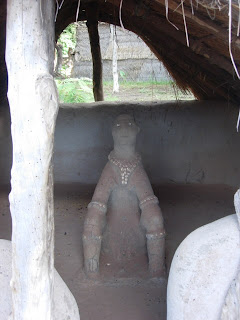
Ok, time for something different – I’ve been meaning for ages to write about the phone system here – which of course is beginning to seem normal to me. Like many things here, it works – after a fashion. And there are workarounds to its limitations.
There are fixed telephone lines, provided by the national Onatel – most companies/organisations and some more affluent private individuals have them. But much more business is transacted from mobiles ‘portables’. Almost everyone I come across in town has one or more of if these, and people’s personal mobiles are routinely used for business purposes – if you want to reach someone, you go for their mobile. In the villages, phone ownership, and network availability, is more spasmodic.
Everyone at work has at least one mobile and there are 2 landlines – one is a ‘ligne verte’, that is a free line (from fixed phones and one network), which was set up as an HIV-AIDS help line, but is now more often used by family and friends as a way of contacting people who work or hang out there; the other is a standard line.
When I first arrived I was puzzled, then, as to why so much time was spent going to the neighbouring telecentre to make calls. There is a telecentre pretty much on every street corner. These are cabins where you can call from a landline, on a meter, and pay afterwards.

There are 3 companies providing mobile services. Calling to the same network is relatively straightforward and cheap, texting more so – although quite often even then calls and texts won’t go through, and the network is quite often too busy. Calling from one network to another is something else. So many people, certainly many people in business like, for example, electricians, will have a SIM card (‘puce’) for each network, and often therefore two or three phones. The networks can be identified by the first two digits of the phone number, so for preference you ring or text your contact from the same network. Or perhaps it may have to be from the network where you currently have some credit… So the directory on my phone has multiple numbers for lots of people, so I can recognise incoming calls, and if possible if I need to contact them, I can do so through my network. As not everyone has as many phones as they have numbers, there is a lot of inserting and removing of SIM cards, and calls and messages are of course missed as a result.
The telecentre is the cheapest way to make calls other than to the same network, and routinely used at work to phone a mobile. So someone may go to the telecentre, call a contact, and ask them to ring back on the ligne verte – and then scurry back to the office.

The fixed lines do work, but are temperamental. Whereas in the UK I was supposed to answer the phone at work within 3 rings, and this was monitored, here it is better to let it ring 3 times before answering, as this improves the success rate.
There are a number of other consequences of this elaborate system – often when someone rings up to speak to one of my colleagues, that person is out at the telecentre making another call; with so many phones in circulation, they are frequently out of battery power, or credit, or both; and a high percentage of all calls seem to consist of someone seeking the number, or the other numbers, of another person..
Ingenuity prevails as ever – there is much use of ‘beeping’ – ie making a call which is terminated before it connects – to deliver simple messages (eg I am ready, call me on the ligne verte…). And there is a cunning system, 'sap sap', which enables you to buy credit for someone else who is somewhere else - you buy the credit and text it to them! Do we have that at home? If so I haven't come across it.
And of course portable phones fulfil many other functions too – they are what people routinely use for calculator, camera, watch, portable music system, and torch. Saves on pocket space. So no wonder there are so many booths selling phones and accessories and carrying out repairs to them – more I think even than bicycle workshops.









